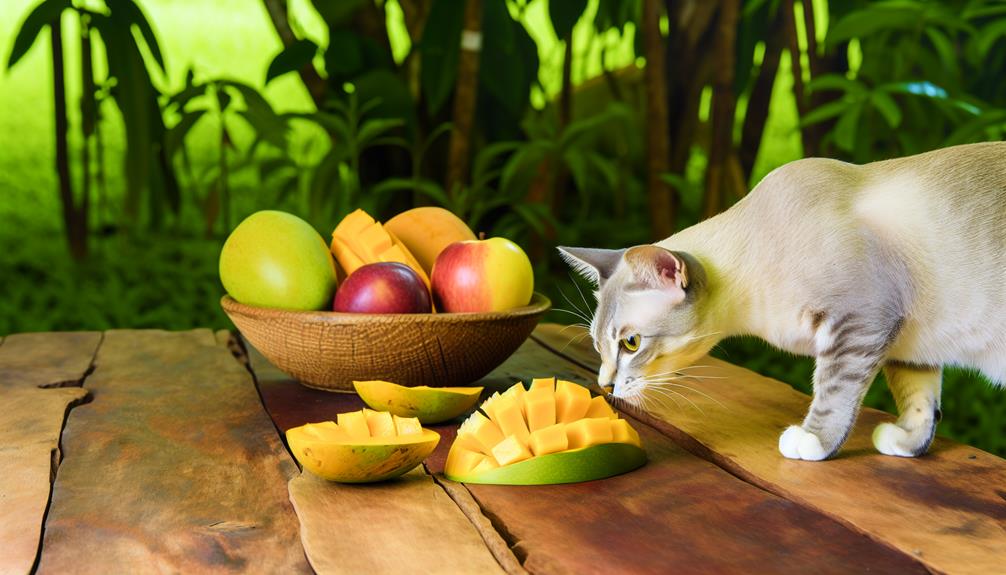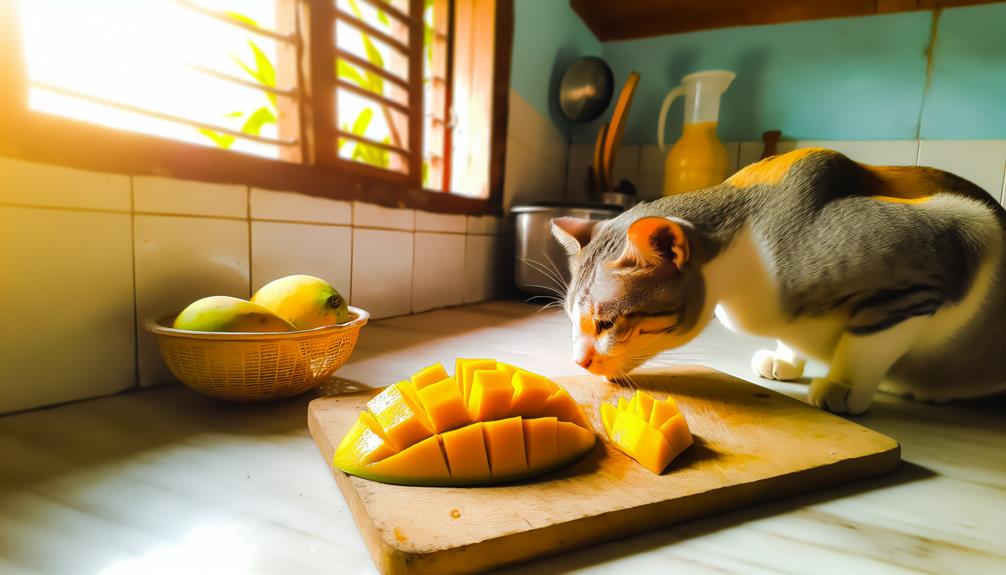You might be wondering if it's safe to share a slice of mango with your feline friend. While cats are obligate carnivores, meaning their primary diet should be meat, small amounts of certain fruits like mango can be a surprising treat. Mango offers some vitamins that could benefit your cat, but its high sugar content and the potential for digestive issues can't be ignored. So, how do you balance the nutritional perks with the possible risks? And what's the best way to introduce this tropical fruit to your cat's diet? Let's explore this further.
Nutritional Content of Mango
When you consider offering mango to your cat, it is important to understand its nutritional content. Mango is rich in various vitamins and minerals, which contribute to its overall nutritional profile. One of the primary benefits of mango is its high vitamin content. Mangoes are packed with vitamins A, B6, C, and E. Vitamin A is essential for maintaining healthy vision and immune function, while vitamin B6 plays a significant role in protein metabolism and neurotransmitter synthesis. Vitamin C acts as an antioxidant, protecting cells from oxidative damage, and vitamin E supports skin health and immune system function.
However, mango also contains natural sugars, which can be a cause for concern. The primary sugars found in mango are fructose, glucose, and sucrose. These mango sugars provide a quick energy source, but they can also contribute to weight gain if consumed in excess. For cats, whose natural diet consists primarily of proteins and fats, the introduction of sugars from fruits like mango should be approached with caution.
In addition to vitamins and sugars, mangoes offer dietary fiber, which aids in digestion. While fiber can benefit the feline digestive system, it is essential to remember that cats are obligate carnivores. Their digestive systems are designed to process meat rather than plant material. As a result, the fiber content in mango should be considered as part of the overall dietary balance.
Is Mango Safe for Cats?
Understanding the nutritional content of mango, it is important to evaluate whether this fruit is safe for feline consumption. While mangoes are rich in vitamins A, C, and E, which are beneficial for humans, the question of safety for cats requires careful examination. Cats are obligate carnivores, meaning their digestive systems are specialized primarily for meat. Consequently, fruit and other plant-based foods can pose potential issues.
First and foremost, mango is non-toxic to cats, meaning it doesn't contain any compounds that are immediately harmful. However, that doesn't mean it is entirely safe. Mango toxicity signs are rare but can include gastrointestinal distress such as vomiting and diarrhea, primarily due to the high sugar content. Cats aren't designed to process large amounts of sugar, which can lead to feline digestion issues.
Another aspect to think about is the mango pit and skin. The pit, or seed, poses a choking hazard and can cause intestinal blockages if ingested. The skin, on the other hand, can be tough and hard to digest, potentially leading to digestive discomfort or even obstruction.
Moreover, introducing any new food should be done gradually. Observing your cat for any adverse reactions after consuming a small piece of mango is vital. If you notice signs of gastrointestinal upset, cease feeding mango immediately and consult a veterinarian.
Health Benefits for Cats

Despite being obligate carnivores, cats can occasionally benefit from small amounts of mango due to its nutrient profile. Mangoes are rich in vitamins A, C, and E, along with dietary fiber, which can support your cat's overall health when offered in moderation. While cats primarily need meat to thrive, these additional nutrients can provide supplementary health advantages.
Nutrient Profile of Mango:
| Nutrient | Benefit for Cats | Amount in Mango (per 100g) |
|---|---|---|
| Vitamin A | Supports vision and immune function | 54 µg |
| Vitamin C | Antioxidant, aids in collagen synthesis | 36.4 mg |
| Dietary Fiber | Promotes healthy cat digestion | 1.6 g |
Vitamin A is essential for maintaining a cat's vision and immune system. Although cats synthesize their own Vitamin C, the antioxidant properties in mango can assist in combating oxidative stress and supporting overall health. The dietary fiber in mango promotes healthy cat digestion, potentially aiding in stool consistency and preventing constipation.
When introducing mango to your cat's diet, it's important to monitor for any signs of feline allergies. Allergic reactions in cats can include symptoms such as itching, swelling, or gastrointestinal upset. Start with a small piece to guarantee your cat doesn't exhibit any adverse reactions.
Potential Risks and Concerns
Although mangoes can offer certain benefits to cats, there are also potential risks and concerns that need to be carefully considered. One of the primary risks is the possibility of allergic reactions. Cats can sometimes exhibit hypersensitivity to certain fruits, including mangoes. Symptoms of an allergic reaction might include itching, swelling, or respiratory distress. If you observe any of these signs after your cat consumes mango, it's vital to consult a veterinarian immediately.
In addition to allergic reactions, digestive issues are another significant concern. Cats have a digestive system that's distinctly different from humans, and their bodies are not designed to process large quantities of fruit. Mangoes contain a high amount of fiber, which can be difficult for cats to digest. This can lead to gastrointestinal disturbances such as diarrhea, vomiting, or constipation. Moreover, the natural sugars present in mangoes, while not toxic, can contribute to obesity and dental problems if consumed in excess.
Additionally, the mango pit poses a choking hazard and contains small amounts of cyanogenic glycosides, which can be toxic if ingested. It's essential always to remove the pit and peel the mango thoroughly to avoid these risks.
Lastly, introducing a new food item like mango into your cat's diet should be done gradually and in moderation. Sudden changes in diet can disrupt your cat's digestive balance, leading to further issues.
How to Serve Mango to Cats

Given the potential risks and concerns associated with feeding mango to cats, it's important to know how to serve it safely. Ensuring proper mango preparation and adhering to specific serving suggestions can minimize any health risks for your feline friend.
First, always opt for ripe, organic mangoes to avoid pesticides and other harmful chemicals. Begin by thoroughly washing the mango to eliminate any surface contaminants. Next, peel the fruit, as the skin can be difficult for cats to digest and may contain residues of pesticides. Remove the pit, which poses a choking hazard and contains cyanogenic glycosides that can be toxic to cats.
Here's a concise guide on mango preparation and serving suggestions:
| Step | Description |
|---|---|
| Wash and Peel | Clean the mango thoroughly and remove the skin to eliminate contaminants. |
| Remove Pit | Carefully extract the pit to prevent choking and toxicity. |
| Cut into Small Pieces | Dice the mango into small, bite-sized portions to facilitate easy digestion. |
When serving mango to your cat, moderation is key. Cats are obligate carnivores and don't require fruits in their diet. Introduce mango gradually, offering no more than a small cube (about 1-2 cm) at a time. Observe your cat for any adverse reactions, such as vomiting or diarrhea. If your cat shows no negative symptoms, you can occasionally treat them to a small piece of mango.
Conclusion
To sum up, think of mango as a delightful treat rather than a dietary staple for your cat. It offers a splash of vitamins A, C, and E, akin to a revitalizing oasis in the desert of their regular diet. However, due to its high sugar content, moderation is key. Always remove the skin and pit, serve in small portions, and watch for any adverse reactions. Your cat's health is paramount, so treat mango as an occasional indulgence.
